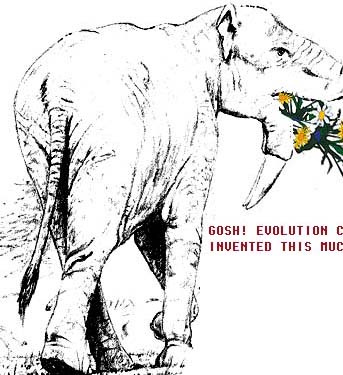Back to previous page of Spring Special?
This was the perfect solution!
|

If you do not hear anything: Listen to this lucky pal! |
| This was the solution! Dinotherium from the Late Tertiary already had a long trunk, the familiar feature of modern elephants. This allows to remove the nose far away from the nasty pollen guys whilst feeding on polleniferous food.
Evolution is great! If only I had such a long nose, I would put it in my pocket when the birch-trees are blooming!
ATISHOO - HATSCHI!!!!
|
When using Netscape 2.0x or higher you should have seen a small animation. Should you not see any animated picture, or no pickture at all, find out about it here!
What's true about this whole story?: Moeritherium actually was an early elephant and must have looked somehow like shown here. The intermediate stage is pure imagination and you better forget about it. Dinotherium was widespread during the Late Tertiary. Evolution of the trunk is rather due to better reaching vegetable food such as tree leafs. Also, elephants cannot bend down their heads because of their short neck. The short neck appears, at least in part, to be due to the large heavy head, which itself is large in order to house the huge grinding teeth. These must be large to efficiently grind the huge amount of daily plant food necessary for an elephant, and so on.... You see, things are complicated.
The fossil pollen and flower examples are from the marvellous book 'Messel - Ein Schaufenster in die Geschichte der Erde und des Lebens' by Schaal and Ziegler (eds). The reconstructions of Moeritherium and Dinotherium are taken from Steven Stanleys great book 'Earth through time and space', one of our standard text books used for lectures (flowers and text added).
Back to page 1 of the Spring special?
Did you miss earlier Specials? You may still VIEW THEM!
 Return to Homepage of www.palaeo.de
Return to Homepage of www.palaeo.de
 Return
Return